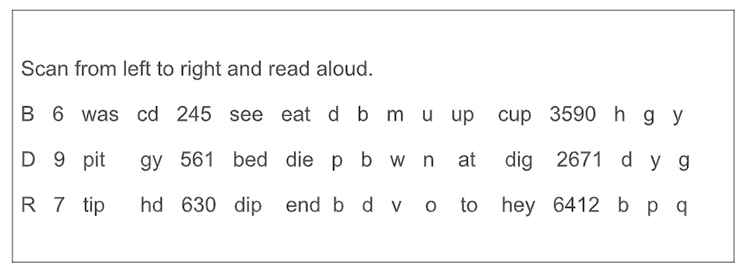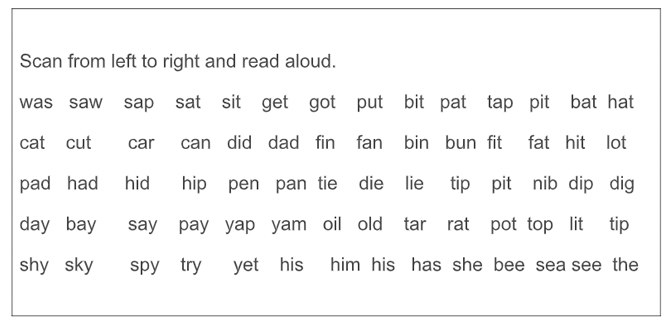Reversals
Some children reverse letters while reading and writing. They have confusion with similar looking letters- p, b, d, and q. Some reverse the entire word-example: was for saw. Some children write dose for does. They have difficulty in copying numbers-example: 576 for 675. They wrongly copy numbers in the maths question paper and get poor marks.
Remedial actions for reversals
- Teach letter names, numbers / dictation of letters / sorting letters /reading from left to right
- The first step is to teach the child letter names and numbers. Buy plastic alphabets and numbers. These three dimensional alphabets and numbers help her to learn to recognize them. Another way to cement memory of letters and numbers is to have them pasted sideways, upside down, at different angles etc, on a sheet of paper. Have the child read them. Dictation is another useful activity.
Related activities in this website: Alphabetic Jigsaw Puzzle, Alphabet Saccades, Identify the Pairs.
- Write letters at random on a paper and require her to sort them. Another activity is to circle a particular letter. See the example below: In this example, the requirement is to circle the letter b.

-
If the child has difficulty in reading letters closely written, spread out the letters. Have tests to circle letters d, h, p, q, etc. Another variation of this test is to require the child to colour letter b green and colour letter d red. Similarly have the child circle letter q green and letter p red. Newspapers can be used to have children identify all ‘b’ in a passage. This activity can be used for identifying any letter which confuses the child. This exercise also helps to develop concentration.
- Let the child read words containing letters which confuse her. For b and d reversals, let her read words having b, words having d, and words having both b and d. Examples: big, bag, ban, bar, bring, brother, bubble, rub, lamb, bomb, dead, did, does, handle, hard, and, dance, bed, band, bread, body, burden, badge, bond, bride, bridge, build.
Search the net for: list of words containing b, list of words containing d, list of words containing b and d. Select words which the child can read comfortably. Prepare a list of words and let the child spend some time daily reading /copying the lists.
Similar exercises can be had for any letters that confuse the child.
- Not reading from left to right is one of the reasons for reversals. To overcome this problem, write letters, numbers and words on a sheet of paper. A board can be used for this purpose. Ask the child to read aloud from left to right. This activity can be done once or twice every day. Let her also read vertically- from top to bottom. One example is given below. Here numbers are also included. After reading aloud from left to right or from top to bottom, have her copy the material.

Parents can prepare their own worksheets.
- Reading similar looking words is an activity which forces children to concentrate. This activity also helps children to learn scanning from left to right. They can try reading from top to bottom. An example is given below. Only three- letter words are used here.

Parents can make their own worksheets.
Search the internet for similar looking words. Use also four letter words or five letter words for this exercise. Search the net for words by length: four letter words, five letter words.
- The first step is to teach the child letter names and numbers. Buy plastic alphabets and numbers. These three dimensional alphabets and numbers help her to learn to recognize them. Another way to cement memory of letters and numbers is to have them pasted sideways, upside down, at different angles etc, on a sheet of paper. Have the child read them. Dictation is another useful activity.
- Tactile and kinesthetic learning
A good remedial activity for reversals of letters and words is writing on sand. The child can write with her index finger letters and words. This is learning by touch. Let the child close her eyes. Write a letter/ a word on her hand and ask her to identify what is written. If her hand is not sensitive enough, write on her back. This is another example of tactile learning. Writing in air slowly with large movements of hand is a useful activity to cement the letters/words in the child’s memory. This is kinesthetic learning.
- Overcoming confusion with directions
A poor sense of direction causes reversals. Some of the activities that help in understanding directionality are given below:
- Have the child perform the following actions:
- Touch her nose with her right hand.
- Lift her right leg.
- Touch her left toe with her right hand.
- Raise both hands and bring her right hand down.
- Bring her right knee up and touch it with her left hand.
- Keep her right hand on her head and cover the right eye with her left hand.
Prepare a list of instructions. A child having problems with directions may take time to follow the instructions. Have the child do these exercises every day till she is able to perform the actions automatically, without pausing to think.
- Give instructions regularly using directions.
Examples of instructions: 1.Open the almirah and take the bag from the bottom drawer. (The instruction would be more effective if a bag is kept in the top drawer as well.) 2. Bring the pen kept on the left side of the English text book. (Keep a pen on the right side of the book as well.) Pick the paper lying under the table. 3. A kitchen can supply lots of questions. What is on the left side of the spoon, Point to a container and ask what is on the right side of it, etc. Use pictures to teach directions. Give instructions using directions- left, right, bottom, top left hand corner, bottom right – to identify things in the picture. Parents can paste pictures on a chart paper and this can be used to teach directions.
Children above nine years can draw maps. Example: The way to- school, a relative’s house, the bus stop, the bank etc. Another exercise is to dictate the way and have the child draw the map. Example: Go straight, take the second left, turn right, take the third left etc.
- Wear a watch/ a ring / a bangle/ remember a scar
Wearing a watch always on the left hand would help to remember the direction left. Similarly wearing a ring can reinforce the understanding of the direction left or right. Another trick is to remember a scar in the body. Relate the scar to the direction left or right.
- Naming the direction of arrows
A widely used activity to teach directionality to children is to name the direction of arrows.
Activity one: To begin with, draw arrows facing up or down. See the example below. Have the child read aloud the direction of the arrows. Also make her point up or down while reading the direction of the arrows.

Activity two: The next stage is to teach left and right directions. Have the child read aloud the direction and at the same time have her point the direction with her hand.
See the example below.

Activity three: In this stage, four directions – up, down, left and right- are used. Have the child read aloud the direction and at the same time have her point the direction with her hand.
See the example below.

Activity four: In this stage, four directions – ↙ slanting down left, ↘ slanting down right, ↖ slanting up left, and ↗ slanting up right - are used. The child reads aloud the direction and at the same time she points the direction with her hand.
See the example below.

Activity five: In this activity, all the eight directions are used. The child reads aloud the direction and also uses her hand to indicate the direction. See the example below.

- Using fingers to learn the shapes of b and d
A common method used to get over the confusion of b and d is to have the children make shapes of b and d with their fingers. See the examples below. Let the children visualize a bed.

Related activities in this website: Identify the Direction, Word Search, Name the Box.
- Have the child perform the following actions:
